Human Resource Management Report: Unilever's Strategies and Practices
VerifiedAdded on 2023/01/19
|21
|5718
|58
Report
AI Summary
This report provides a comprehensive overview of Human Resource Management (HRM) principles and practices, focusing on their application within a corporate context, specifically referencing Unilever. The report explores the core functions of HRM, including workforce planning, recruitment and selection, training and development, performance management, and compensation and benefits. It examines the strengths and weaknesses of various recruitment and selection approaches, analyzes the benefits of effective HRM practices for both employers and employees, and evaluates the impact of HRM on organizational profit and productivity. Furthermore, it emphasizes the importance of employee relations in HRM decision-making and identifies the key elements of employment legislation and its impact. The report uses specific examples, such as the person specification for a receptionist role, to illustrate the practical application of HRM practices. The report also discusses flexible working arrangements offered by Microsoft. The report concludes by summarizing the key findings and their implications for effective HRM within organizations.
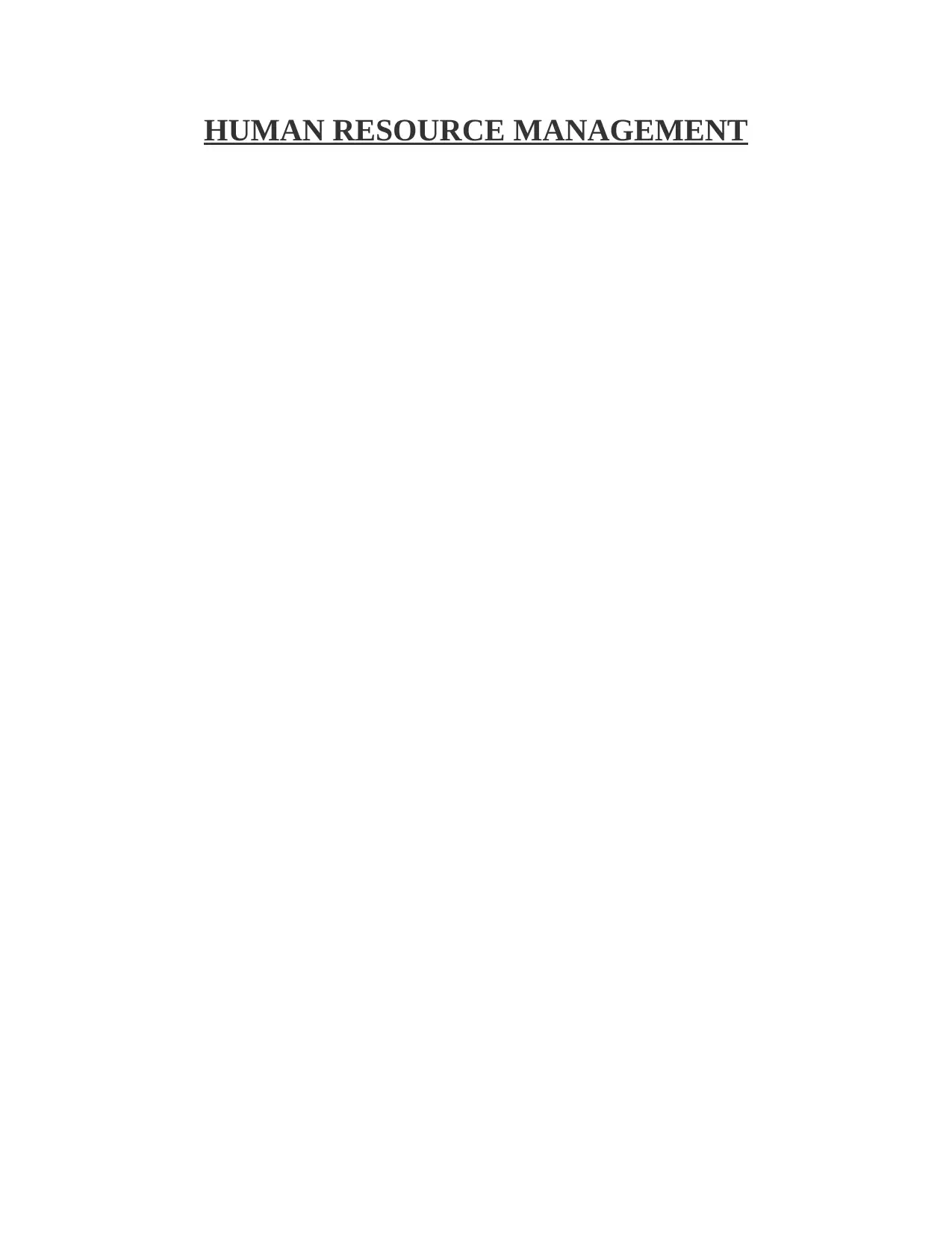
HUMAN RESOURCE MANAGEMENT
Paraphrase This Document
Need a fresh take? Get an instant paraphrase of this document with our AI Paraphraser
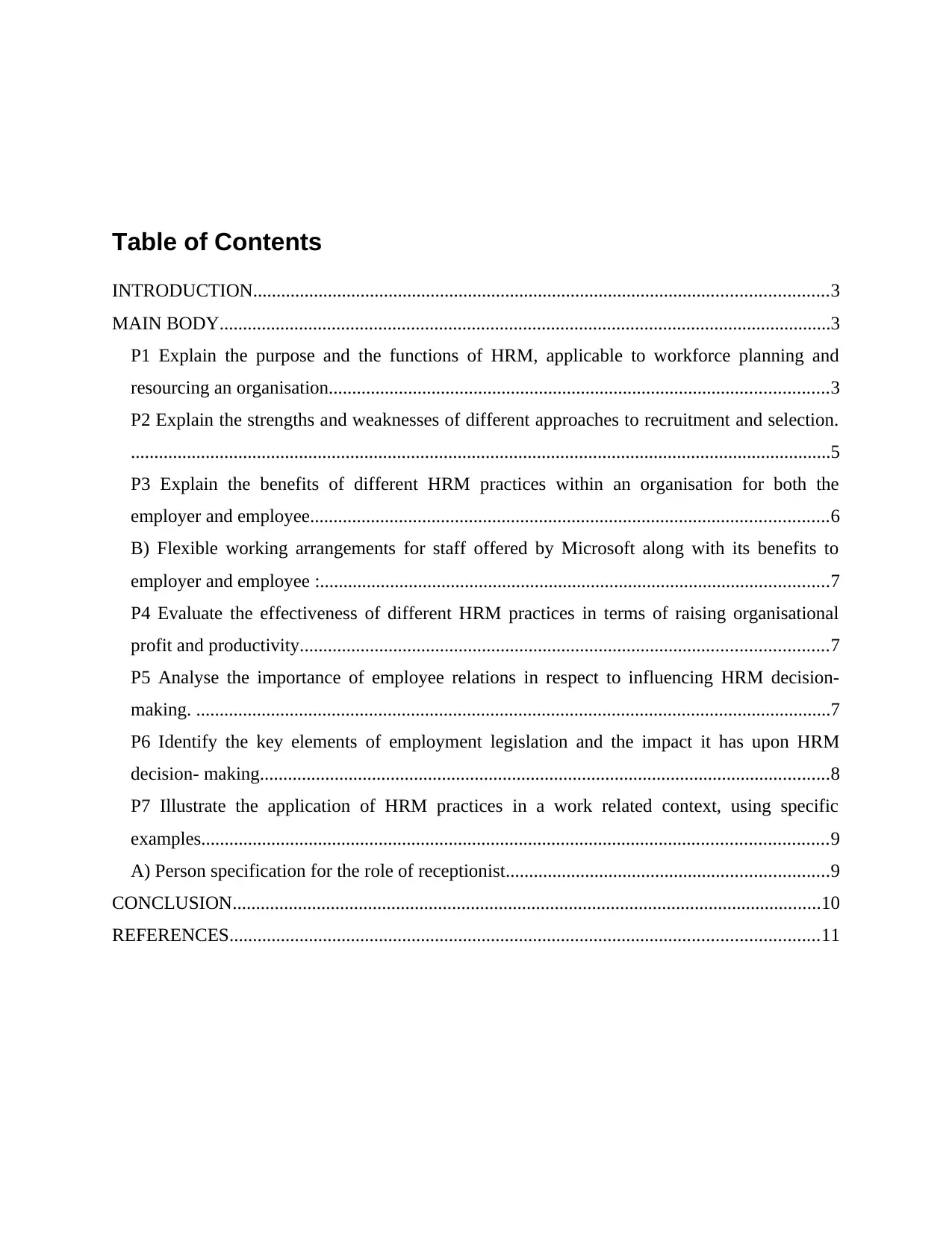
Table of Contents
INTRODUCTION...........................................................................................................................3
MAIN BODY...................................................................................................................................3
P1 Explain the purpose and the functions of HRM, applicable to workforce planning and
resourcing an organisation...........................................................................................................3
P2 Explain the strengths and weaknesses of different approaches to recruitment and selection.
......................................................................................................................................................5
P3 Explain the benefits of different HRM practices within an organisation for both the
employer and employee...............................................................................................................6
B) Flexible working arrangements for staff offered by Microsoft along with its benefits to
employer and employee :.............................................................................................................7
P4 Evaluate the effectiveness of different HRM practices in terms of raising organisational
profit and productivity.................................................................................................................7
P5 Analyse the importance of employee relations in respect to influencing HRM decision-
making. ........................................................................................................................................7
P6 Identify the key elements of employment legislation and the impact it has upon HRM
decision- making..........................................................................................................................8
P7 Illustrate the application of HRM practices in a work related context, using specific
examples......................................................................................................................................9
A) Person specification for the role of receptionist.....................................................................9
CONCLUSION..............................................................................................................................10
REFERENCES..............................................................................................................................11
INTRODUCTION...........................................................................................................................3
MAIN BODY...................................................................................................................................3
P1 Explain the purpose and the functions of HRM, applicable to workforce planning and
resourcing an organisation...........................................................................................................3
P2 Explain the strengths and weaknesses of different approaches to recruitment and selection.
......................................................................................................................................................5
P3 Explain the benefits of different HRM practices within an organisation for both the
employer and employee...............................................................................................................6
B) Flexible working arrangements for staff offered by Microsoft along with its benefits to
employer and employee :.............................................................................................................7
P4 Evaluate the effectiveness of different HRM practices in terms of raising organisational
profit and productivity.................................................................................................................7
P5 Analyse the importance of employee relations in respect to influencing HRM decision-
making. ........................................................................................................................................7
P6 Identify the key elements of employment legislation and the impact it has upon HRM
decision- making..........................................................................................................................8
P7 Illustrate the application of HRM practices in a work related context, using specific
examples......................................................................................................................................9
A) Person specification for the role of receptionist.....................................................................9
CONCLUSION..............................................................................................................................10
REFERENCES..............................................................................................................................11
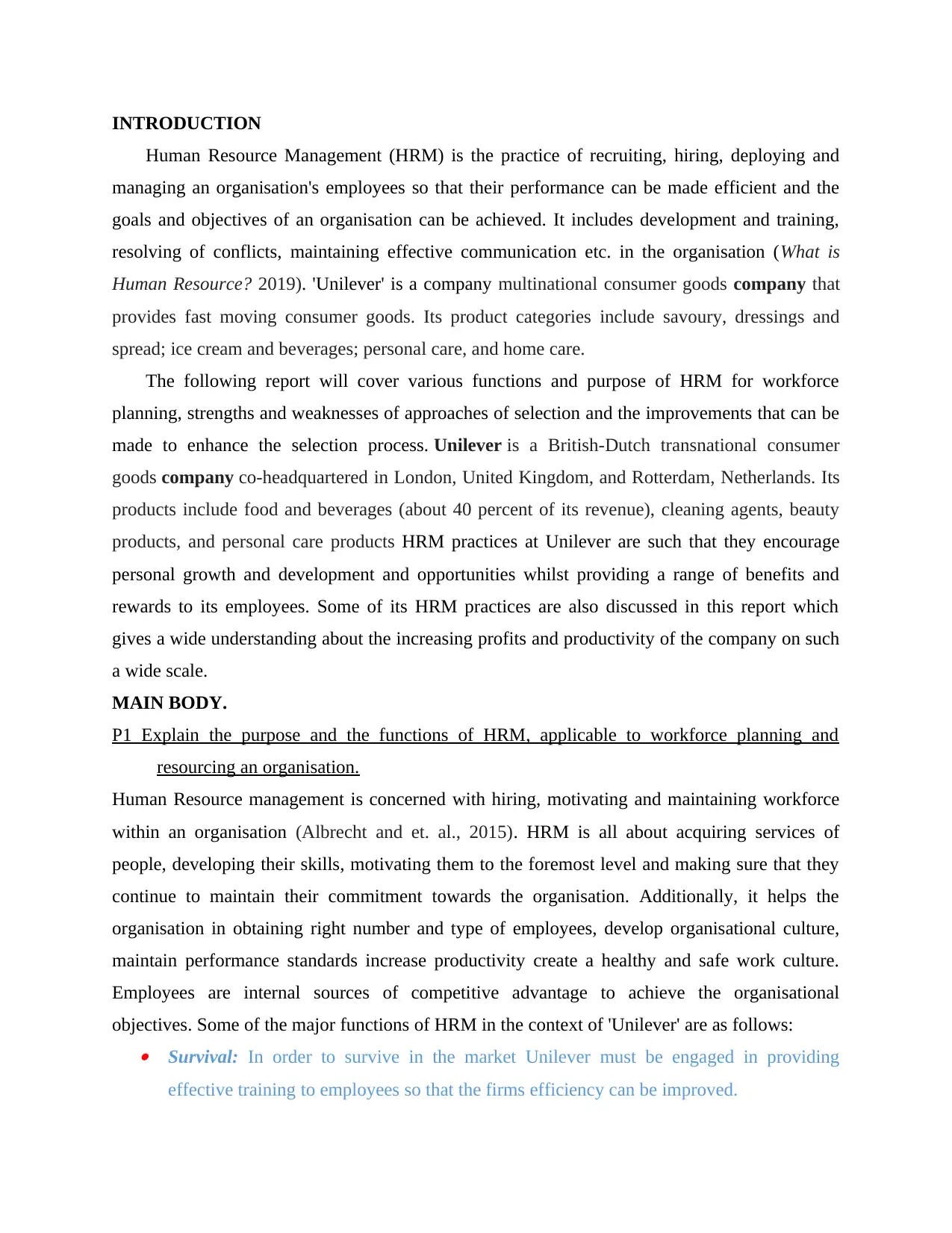
INTRODUCTION
Human Resource Management (HRM) is the practice of recruiting, hiring, deploying and
managing an organisation's employees so that their performance can be made efficient and the
goals and objectives of an organisation can be achieved. It includes development and training,
resolving of conflicts, maintaining effective communication etc. in the organisation (What is
Human Resource? 2019). 'Unilever' is a company multinational consumer goods company that
provides fast moving consumer goods. Its product categories include savoury, dressings and
spread; ice cream and beverages; personal care, and home care.
The following report will cover various functions and purpose of HRM for workforce
planning, strengths and weaknesses of approaches of selection and the improvements that can be
made to enhance the selection process. Unilever is a British-Dutch transnational consumer
goods company co-headquartered in London, United Kingdom, and Rotterdam, Netherlands. Its
products include food and beverages (about 40 percent of its revenue), cleaning agents, beauty
products, and personal care products HRM practices at Unilever are such that they encourage
personal growth and development and opportunities whilst providing a range of benefits and
rewards to its employees. Some of its HRM practices are also discussed in this report which
gives a wide understanding about the increasing profits and productivity of the company on such
a wide scale.
MAIN BODY.
P1 Explain the purpose and the functions of HRM, applicable to workforce planning and
resourcing an organisation.
Human Resource management is concerned with hiring, motivating and maintaining workforce
within an organisation (Albrecht and et. al., 2015). HRM is all about acquiring services of
people, developing their skills, motivating them to the foremost level and making sure that they
continue to maintain their commitment towards the organisation. Additionally, it helps the
organisation in obtaining right number and type of employees, develop organisational culture,
maintain performance standards increase productivity create a healthy and safe work culture.
Employees are internal sources of competitive advantage to achieve the organisational
objectives. Some of the major functions of HRM in the context of 'Unilever' are as follows: Survival: In order to survive in the market Unilever must be engaged in providing
effective training to employees so that the firms efficiency can be improved.
Human Resource Management (HRM) is the practice of recruiting, hiring, deploying and
managing an organisation's employees so that their performance can be made efficient and the
goals and objectives of an organisation can be achieved. It includes development and training,
resolving of conflicts, maintaining effective communication etc. in the organisation (What is
Human Resource? 2019). 'Unilever' is a company multinational consumer goods company that
provides fast moving consumer goods. Its product categories include savoury, dressings and
spread; ice cream and beverages; personal care, and home care.
The following report will cover various functions and purpose of HRM for workforce
planning, strengths and weaknesses of approaches of selection and the improvements that can be
made to enhance the selection process. Unilever is a British-Dutch transnational consumer
goods company co-headquartered in London, United Kingdom, and Rotterdam, Netherlands. Its
products include food and beverages (about 40 percent of its revenue), cleaning agents, beauty
products, and personal care products HRM practices at Unilever are such that they encourage
personal growth and development and opportunities whilst providing a range of benefits and
rewards to its employees. Some of its HRM practices are also discussed in this report which
gives a wide understanding about the increasing profits and productivity of the company on such
a wide scale.
MAIN BODY.
P1 Explain the purpose and the functions of HRM, applicable to workforce planning and
resourcing an organisation.
Human Resource management is concerned with hiring, motivating and maintaining workforce
within an organisation (Albrecht and et. al., 2015). HRM is all about acquiring services of
people, developing their skills, motivating them to the foremost level and making sure that they
continue to maintain their commitment towards the organisation. Additionally, it helps the
organisation in obtaining right number and type of employees, develop organisational culture,
maintain performance standards increase productivity create a healthy and safe work culture.
Employees are internal sources of competitive advantage to achieve the organisational
objectives. Some of the major functions of HRM in the context of 'Unilever' are as follows: Survival: In order to survive in the market Unilever must be engaged in providing
effective training to employees so that the firms efficiency can be improved.
⊘ This is a preview!⊘
Do you want full access?
Subscribe today to unlock all pages.

Trusted by 1+ million students worldwide
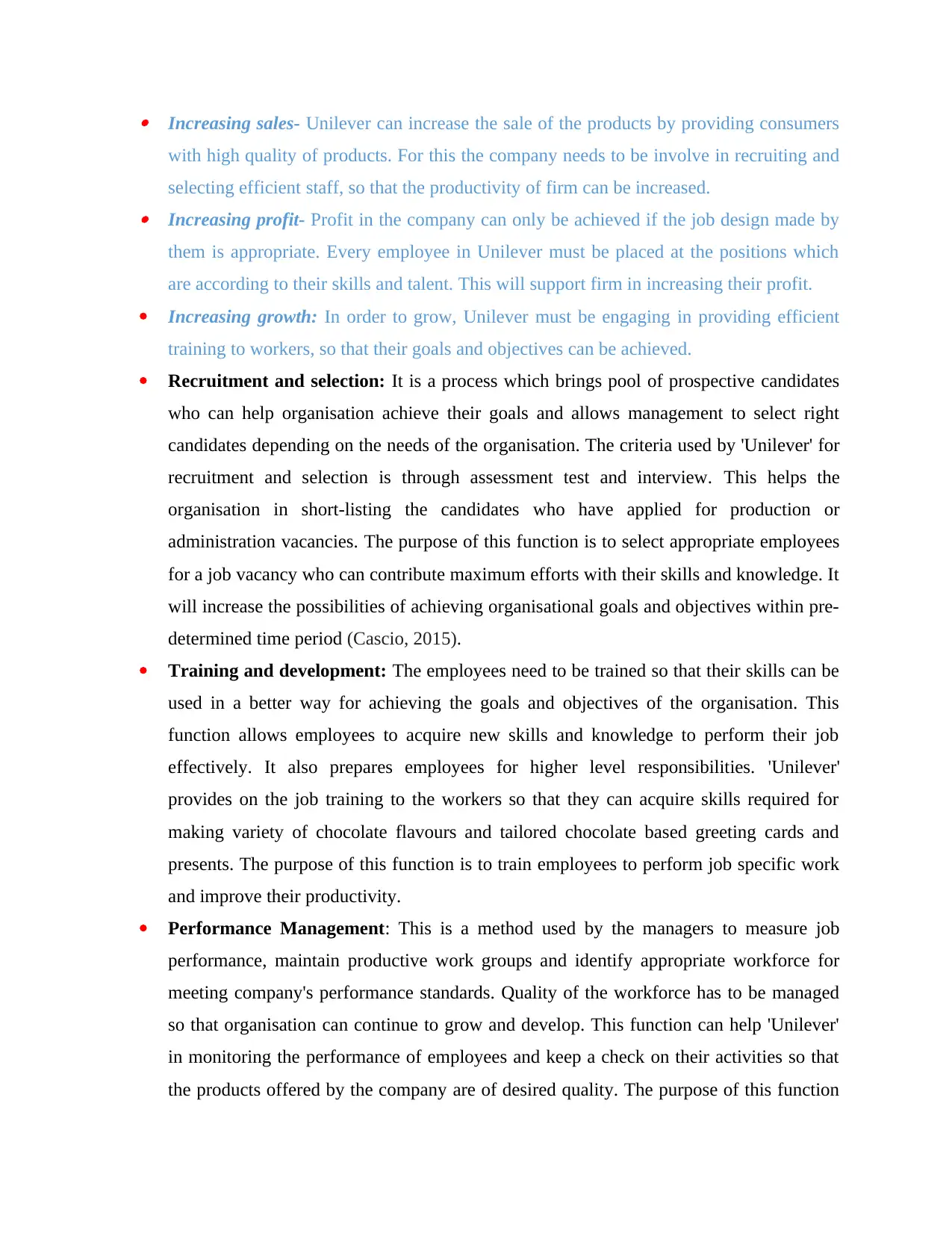
Increasing sales- Unilever can increase the sale of the products by providing consumers
with high quality of products. For this the company needs to be involve in recruiting and
selecting efficient staff, so that the productivity of firm can be increased. Increasing profit- Profit in the company can only be achieved if the job design made by
them is appropriate. Every employee in Unilever must be placed at the positions which
are according to their skills and talent. This will support firm in increasing their profit.
Increasing growth: In order to grow, Unilever must be engaging in providing efficient
training to workers, so that their goals and objectives can be achieved.
Recruitment and selection: It is a process which brings pool of prospective candidates
who can help organisation achieve their goals and allows management to select right
candidates depending on the needs of the organisation. The criteria used by 'Unilever' for
recruitment and selection is through assessment test and interview. This helps the
organisation in short-listing the candidates who have applied for production or
administration vacancies. The purpose of this function is to select appropriate employees
for a job vacancy who can contribute maximum efforts with their skills and knowledge. It
will increase the possibilities of achieving organisational goals and objectives within pre-
determined time period (Cascio, 2015).
Training and development: The employees need to be trained so that their skills can be
used in a better way for achieving the goals and objectives of the organisation. This
function allows employees to acquire new skills and knowledge to perform their job
effectively. It also prepares employees for higher level responsibilities. 'Unilever'
provides on the job training to the workers so that they can acquire skills required for
making variety of chocolate flavours and tailored chocolate based greeting cards and
presents. The purpose of this function is to train employees to perform job specific work
and improve their productivity.
Performance Management: This is a method used by the managers to measure job
performance, maintain productive work groups and identify appropriate workforce for
meeting company's performance standards. Quality of the workforce has to be managed
so that organisation can continue to grow and develop. This function can help 'Unilever'
in monitoring the performance of employees and keep a check on their activities so that
the products offered by the company are of desired quality. The purpose of this function
with high quality of products. For this the company needs to be involve in recruiting and
selecting efficient staff, so that the productivity of firm can be increased. Increasing profit- Profit in the company can only be achieved if the job design made by
them is appropriate. Every employee in Unilever must be placed at the positions which
are according to their skills and talent. This will support firm in increasing their profit.
Increasing growth: In order to grow, Unilever must be engaging in providing efficient
training to workers, so that their goals and objectives can be achieved.
Recruitment and selection: It is a process which brings pool of prospective candidates
who can help organisation achieve their goals and allows management to select right
candidates depending on the needs of the organisation. The criteria used by 'Unilever' for
recruitment and selection is through assessment test and interview. This helps the
organisation in short-listing the candidates who have applied for production or
administration vacancies. The purpose of this function is to select appropriate employees
for a job vacancy who can contribute maximum efforts with their skills and knowledge. It
will increase the possibilities of achieving organisational goals and objectives within pre-
determined time period (Cascio, 2015).
Training and development: The employees need to be trained so that their skills can be
used in a better way for achieving the goals and objectives of the organisation. This
function allows employees to acquire new skills and knowledge to perform their job
effectively. It also prepares employees for higher level responsibilities. 'Unilever'
provides on the job training to the workers so that they can acquire skills required for
making variety of chocolate flavours and tailored chocolate based greeting cards and
presents. The purpose of this function is to train employees to perform job specific work
and improve their productivity.
Performance Management: This is a method used by the managers to measure job
performance, maintain productive work groups and identify appropriate workforce for
meeting company's performance standards. Quality of the workforce has to be managed
so that organisation can continue to grow and develop. This function can help 'Unilever'
in monitoring the performance of employees and keep a check on their activities so that
the products offered by the company are of desired quality. The purpose of this function
Paraphrase This Document
Need a fresh take? Get an instant paraphrase of this document with our AI Paraphraser
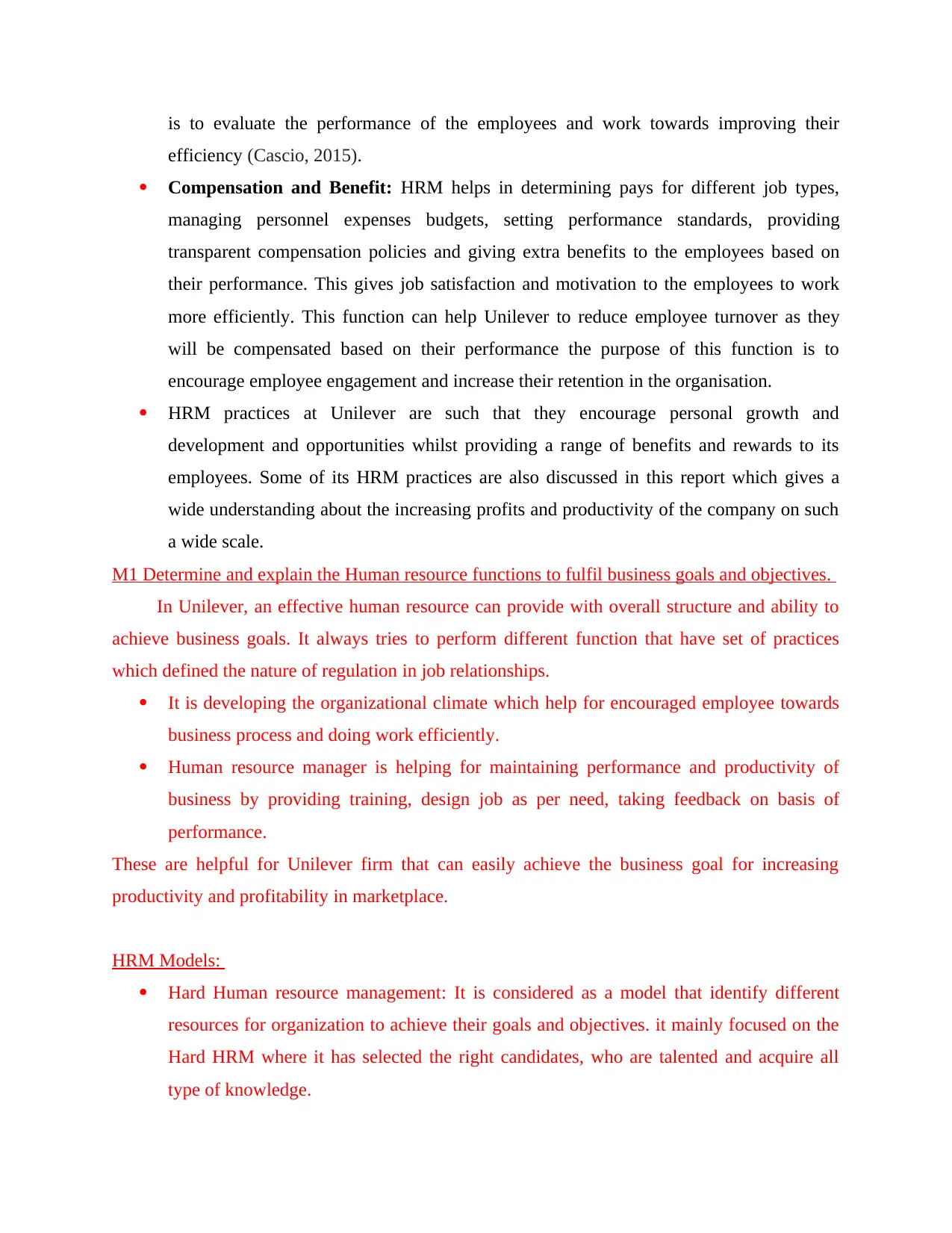
is to evaluate the performance of the employees and work towards improving their
efficiency (Cascio, 2015).
Compensation and Benefit: HRM helps in determining pays for different job types,
managing personnel expenses budgets, setting performance standards, providing
transparent compensation policies and giving extra benefits to the employees based on
their performance. This gives job satisfaction and motivation to the employees to work
more efficiently. This function can help Unilever to reduce employee turnover as they
will be compensated based on their performance the purpose of this function is to
encourage employee engagement and increase their retention in the organisation.
HRM practices at Unilever are such that they encourage personal growth and
development and opportunities whilst providing a range of benefits and rewards to its
employees. Some of its HRM practices are also discussed in this report which gives a
wide understanding about the increasing profits and productivity of the company on such
a wide scale.
M1 Determine and explain the Human resource functions to fulfil business goals and objectives.
In Unilever, an effective human resource can provide with overall structure and ability to
achieve business goals. It always tries to perform different function that have set of practices
which defined the nature of regulation in job relationships.
It is developing the organizational climate which help for encouraged employee towards
business process and doing work efficiently.
Human resource manager is helping for maintaining performance and productivity of
business by providing training, design job as per need, taking feedback on basis of
performance.
These are helpful for Unilever firm that can easily achieve the business goal for increasing
productivity and profitability in marketplace.
HRM Models:
Hard Human resource management: It is considered as a model that identify different
resources for organization to achieve their goals and objectives. it mainly focused on the
Hard HRM where it has selected the right candidates, who are talented and acquire all
type of knowledge.
efficiency (Cascio, 2015).
Compensation and Benefit: HRM helps in determining pays for different job types,
managing personnel expenses budgets, setting performance standards, providing
transparent compensation policies and giving extra benefits to the employees based on
their performance. This gives job satisfaction and motivation to the employees to work
more efficiently. This function can help Unilever to reduce employee turnover as they
will be compensated based on their performance the purpose of this function is to
encourage employee engagement and increase their retention in the organisation.
HRM practices at Unilever are such that they encourage personal growth and
development and opportunities whilst providing a range of benefits and rewards to its
employees. Some of its HRM practices are also discussed in this report which gives a
wide understanding about the increasing profits and productivity of the company on such
a wide scale.
M1 Determine and explain the Human resource functions to fulfil business goals and objectives.
In Unilever, an effective human resource can provide with overall structure and ability to
achieve business goals. It always tries to perform different function that have set of practices
which defined the nature of regulation in job relationships.
It is developing the organizational climate which help for encouraged employee towards
business process and doing work efficiently.
Human resource manager is helping for maintaining performance and productivity of
business by providing training, design job as per need, taking feedback on basis of
performance.
These are helpful for Unilever firm that can easily achieve the business goal for increasing
productivity and profitability in marketplace.
HRM Models:
Hard Human resource management: It is considered as a model that identify different
resources for organization to achieve their goals and objectives. it mainly focused on the
Hard HRM where it has selected the right candidates, who are talented and acquire all
type of knowledge.
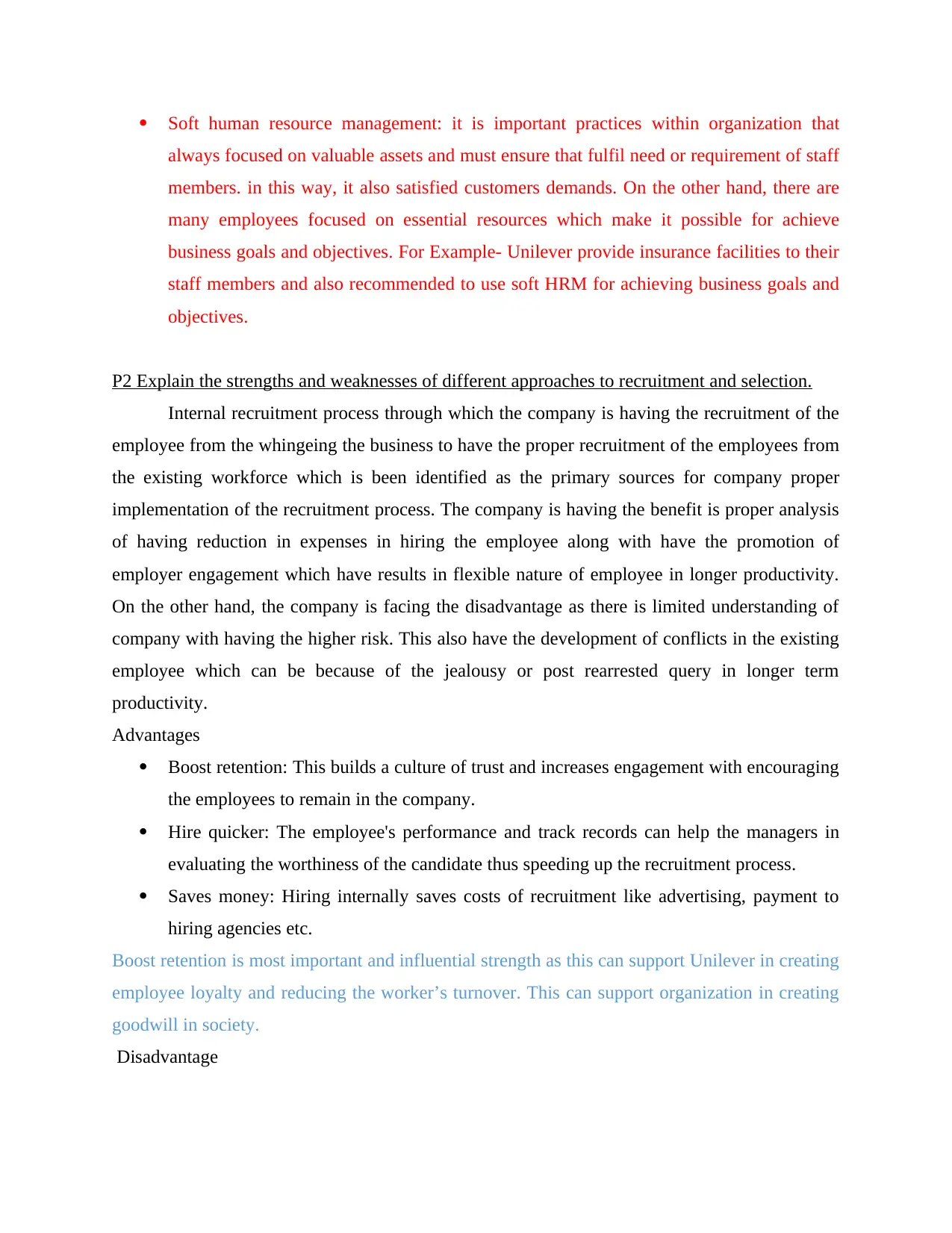
Soft human resource management: it is important practices within organization that
always focused on valuable assets and must ensure that fulfil need or requirement of staff
members. in this way, it also satisfied customers demands. On the other hand, there are
many employees focused on essential resources which make it possible for achieve
business goals and objectives. For Example- Unilever provide insurance facilities to their
staff members and also recommended to use soft HRM for achieving business goals and
objectives.
P2 Explain the strengths and weaknesses of different approaches to recruitment and selection.
Internal recruitment process through which the company is having the recruitment of the
employee from the whingeing the business to have the proper recruitment of the employees from
the existing workforce which is been identified as the primary sources for company proper
implementation of the recruitment process. The company is having the benefit is proper analysis
of having reduction in expenses in hiring the employee along with have the promotion of
employer engagement which have results in flexible nature of employee in longer productivity.
On the other hand, the company is facing the disadvantage as there is limited understanding of
company with having the higher risk. This also have the development of conflicts in the existing
employee which can be because of the jealousy or post rearrested query in longer term
productivity.
Advantages
Boost retention: This builds a culture of trust and increases engagement with encouraging
the employees to remain in the company.
Hire quicker: The employee's performance and track records can help the managers in
evaluating the worthiness of the candidate thus speeding up the recruitment process.
Saves money: Hiring internally saves costs of recruitment like advertising, payment to
hiring agencies etc.
Boost retention is most important and influential strength as this can support Unilever in creating
employee loyalty and reducing the worker’s turnover. This can support organization in creating
goodwill in society.
Disadvantage
always focused on valuable assets and must ensure that fulfil need or requirement of staff
members. in this way, it also satisfied customers demands. On the other hand, there are
many employees focused on essential resources which make it possible for achieve
business goals and objectives. For Example- Unilever provide insurance facilities to their
staff members and also recommended to use soft HRM for achieving business goals and
objectives.
P2 Explain the strengths and weaknesses of different approaches to recruitment and selection.
Internal recruitment process through which the company is having the recruitment of the
employee from the whingeing the business to have the proper recruitment of the employees from
the existing workforce which is been identified as the primary sources for company proper
implementation of the recruitment process. The company is having the benefit is proper analysis
of having reduction in expenses in hiring the employee along with have the promotion of
employer engagement which have results in flexible nature of employee in longer productivity.
On the other hand, the company is facing the disadvantage as there is limited understanding of
company with having the higher risk. This also have the development of conflicts in the existing
employee which can be because of the jealousy or post rearrested query in longer term
productivity.
Advantages
Boost retention: This builds a culture of trust and increases engagement with encouraging
the employees to remain in the company.
Hire quicker: The employee's performance and track records can help the managers in
evaluating the worthiness of the candidate thus speeding up the recruitment process.
Saves money: Hiring internally saves costs of recruitment like advertising, payment to
hiring agencies etc.
Boost retention is most important and influential strength as this can support Unilever in creating
employee loyalty and reducing the worker’s turnover. This can support organization in creating
goodwill in society.
Disadvantage
⊘ This is a preview!⊘
Do you want full access?
Subscribe today to unlock all pages.

Trusted by 1+ million students worldwide
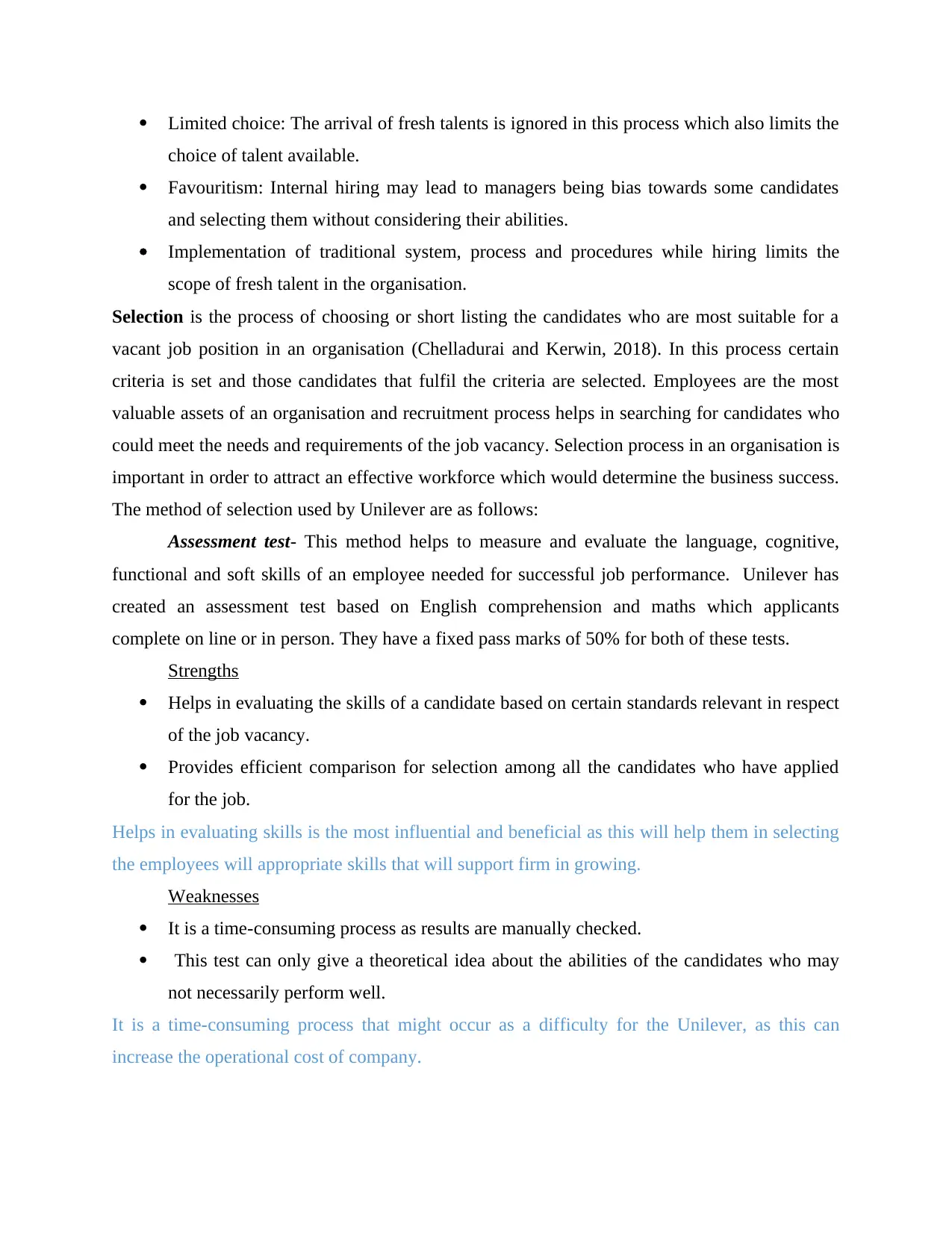
Limited choice: The arrival of fresh talents is ignored in this process which also limits the
choice of talent available.
Favouritism: Internal hiring may lead to managers being bias towards some candidates
and selecting them without considering their abilities.
Implementation of traditional system, process and procedures while hiring limits the
scope of fresh talent in the organisation.
Selection is the process of choosing or short listing the candidates who are most suitable for a
vacant job position in an organisation (Chelladurai and Kerwin, 2018). In this process certain
criteria is set and those candidates that fulfil the criteria are selected. Employees are the most
valuable assets of an organisation and recruitment process helps in searching for candidates who
could meet the needs and requirements of the job vacancy. Selection process in an organisation is
important in order to attract an effective workforce which would determine the business success.
The method of selection used by Unilever are as follows:
Assessment test- This method helps to measure and evaluate the language, cognitive,
functional and soft skills of an employee needed for successful job performance. Unilever has
created an assessment test based on English comprehension and maths which applicants
complete on line or in person. They have a fixed pass marks of 50% for both of these tests.
Strengths
Helps in evaluating the skills of a candidate based on certain standards relevant in respect
of the job vacancy.
Provides efficient comparison for selection among all the candidates who have applied
for the job.
Helps in evaluating skills is the most influential and beneficial as this will help them in selecting
the employees will appropriate skills that will support firm in growing.
Weaknesses
It is a time-consuming process as results are manually checked.
This test can only give a theoretical idea about the abilities of the candidates who may
not necessarily perform well.
It is a time-consuming process that might occur as a difficulty for the Unilever, as this can
increase the operational cost of company.
choice of talent available.
Favouritism: Internal hiring may lead to managers being bias towards some candidates
and selecting them without considering their abilities.
Implementation of traditional system, process and procedures while hiring limits the
scope of fresh talent in the organisation.
Selection is the process of choosing or short listing the candidates who are most suitable for a
vacant job position in an organisation (Chelladurai and Kerwin, 2018). In this process certain
criteria is set and those candidates that fulfil the criteria are selected. Employees are the most
valuable assets of an organisation and recruitment process helps in searching for candidates who
could meet the needs and requirements of the job vacancy. Selection process in an organisation is
important in order to attract an effective workforce which would determine the business success.
The method of selection used by Unilever are as follows:
Assessment test- This method helps to measure and evaluate the language, cognitive,
functional and soft skills of an employee needed for successful job performance. Unilever has
created an assessment test based on English comprehension and maths which applicants
complete on line or in person. They have a fixed pass marks of 50% for both of these tests.
Strengths
Helps in evaluating the skills of a candidate based on certain standards relevant in respect
of the job vacancy.
Provides efficient comparison for selection among all the candidates who have applied
for the job.
Helps in evaluating skills is the most influential and beneficial as this will help them in selecting
the employees will appropriate skills that will support firm in growing.
Weaknesses
It is a time-consuming process as results are manually checked.
This test can only give a theoretical idea about the abilities of the candidates who may
not necessarily perform well.
It is a time-consuming process that might occur as a difficulty for the Unilever, as this can
increase the operational cost of company.
Paraphrase This Document
Need a fresh take? Get an instant paraphrase of this document with our AI Paraphraser
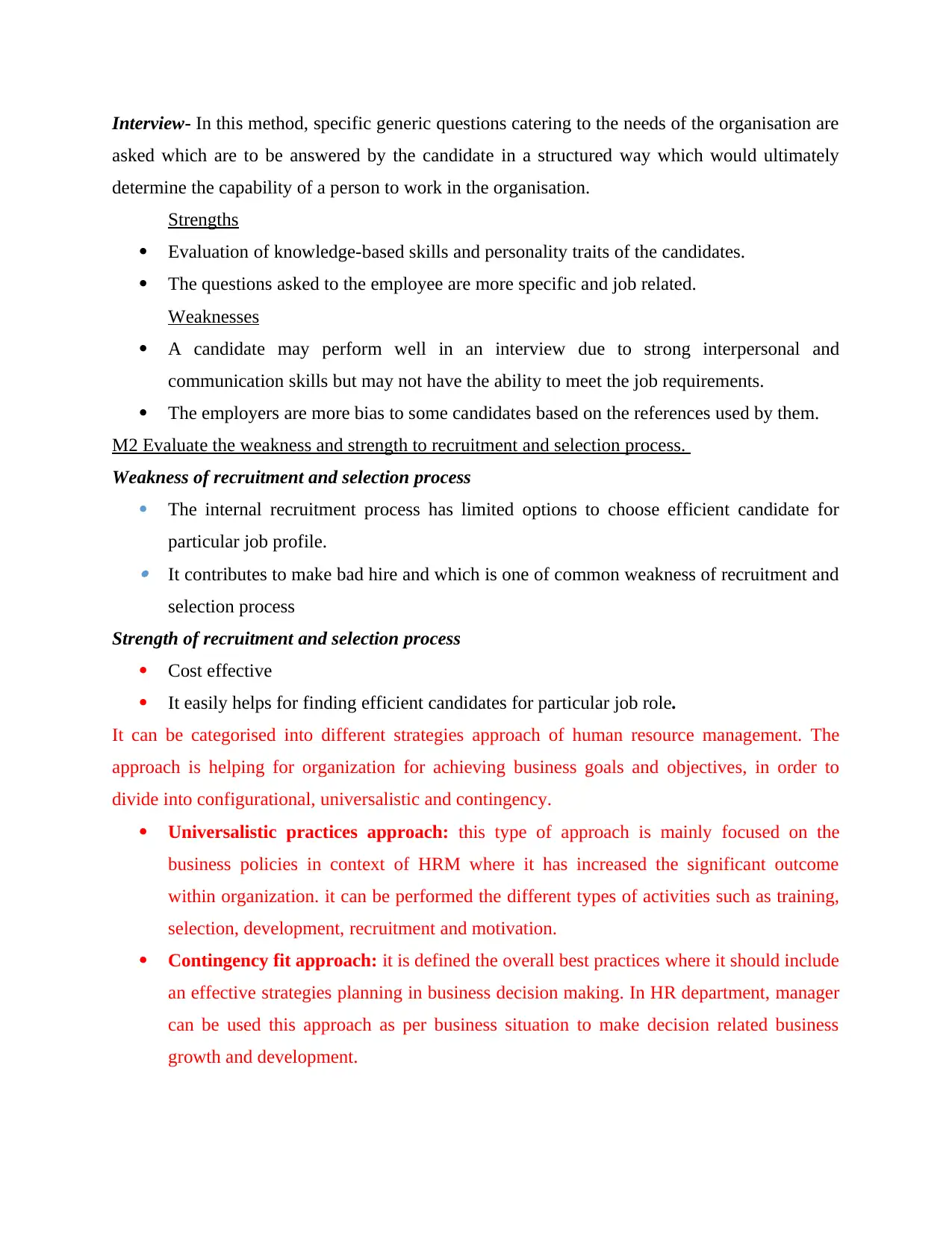
Interview- In this method, specific generic questions catering to the needs of the organisation are
asked which are to be answered by the candidate in a structured way which would ultimately
determine the capability of a person to work in the organisation.
Strengths
Evaluation of knowledge-based skills and personality traits of the candidates.
The questions asked to the employee are more specific and job related.
Weaknesses
A candidate may perform well in an interview due to strong interpersonal and
communication skills but may not have the ability to meet the job requirements.
The employers are more bias to some candidates based on the references used by them.
M2 Evaluate the weakness and strength to recruitment and selection process.
Weakness of recruitment and selection process
The internal recruitment process has limited options to choose efficient candidate for
particular job profile. It contributes to make bad hire and which is one of common weakness of recruitment and
selection process
Strength of recruitment and selection process
Cost effective
It easily helps for finding efficient candidates for particular job role.
It can be categorised into different strategies approach of human resource management. The
approach is helping for organization for achieving business goals and objectives, in order to
divide into configurational, universalistic and contingency.
Universalistic practices approach: this type of approach is mainly focused on the
business policies in context of HRM where it has increased the significant outcome
within organization. it can be performed the different types of activities such as training,
selection, development, recruitment and motivation.
Contingency fit approach: it is defined the overall best practices where it should include
an effective strategies planning in business decision making. In HR department, manager
can be used this approach as per business situation to make decision related business
growth and development.
asked which are to be answered by the candidate in a structured way which would ultimately
determine the capability of a person to work in the organisation.
Strengths
Evaluation of knowledge-based skills and personality traits of the candidates.
The questions asked to the employee are more specific and job related.
Weaknesses
A candidate may perform well in an interview due to strong interpersonal and
communication skills but may not have the ability to meet the job requirements.
The employers are more bias to some candidates based on the references used by them.
M2 Evaluate the weakness and strength to recruitment and selection process.
Weakness of recruitment and selection process
The internal recruitment process has limited options to choose efficient candidate for
particular job profile. It contributes to make bad hire and which is one of common weakness of recruitment and
selection process
Strength of recruitment and selection process
Cost effective
It easily helps for finding efficient candidates for particular job role.
It can be categorised into different strategies approach of human resource management. The
approach is helping for organization for achieving business goals and objectives, in order to
divide into configurational, universalistic and contingency.
Universalistic practices approach: this type of approach is mainly focused on the
business policies in context of HRM where it has increased the significant outcome
within organization. it can be performed the different types of activities such as training,
selection, development, recruitment and motivation.
Contingency fit approach: it is defined the overall best practices where it should include
an effective strategies planning in business decision making. In HR department, manager
can be used this approach as per business situation to make decision related business
growth and development.
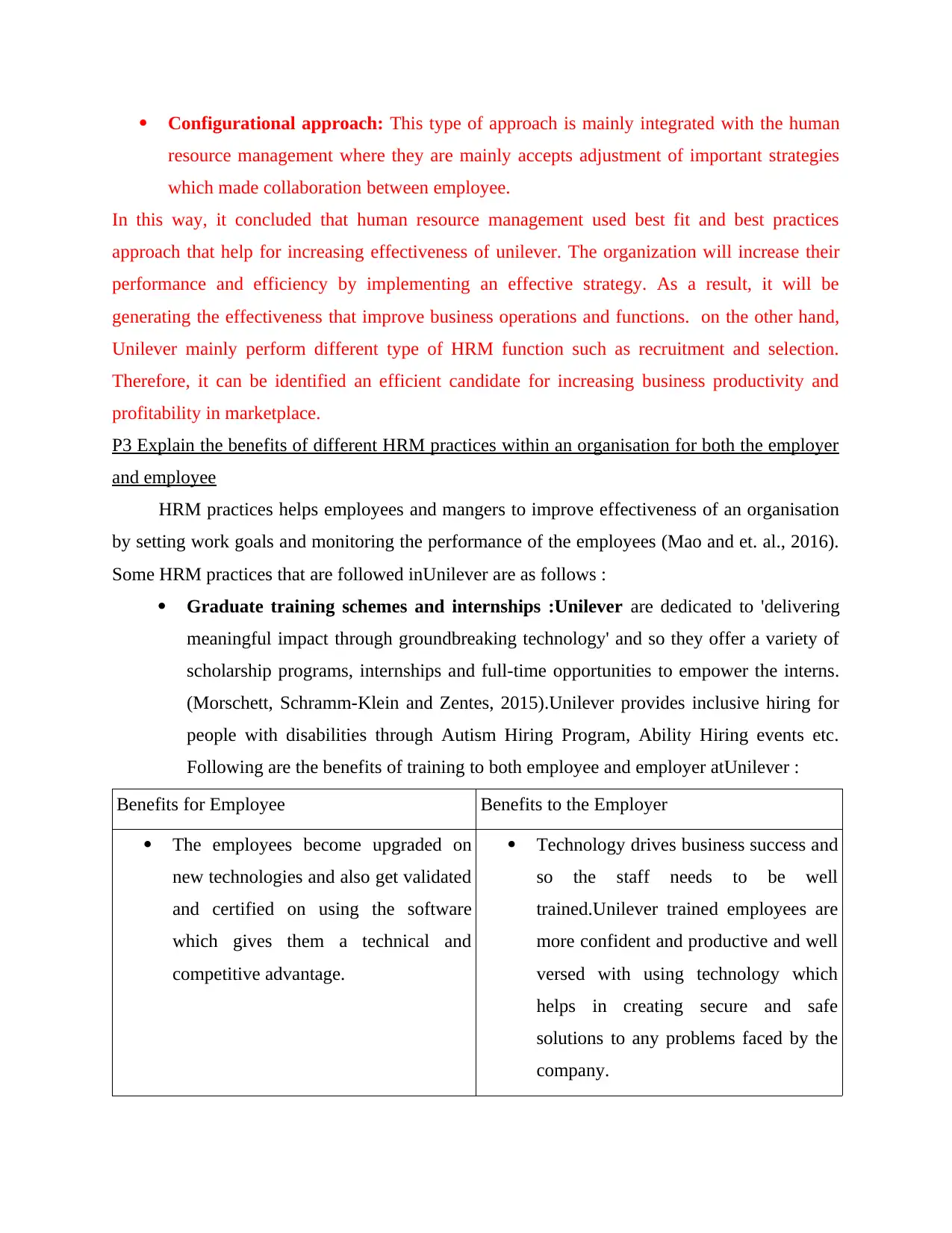
Configurational approach: This type of approach is mainly integrated with the human
resource management where they are mainly accepts adjustment of important strategies
which made collaboration between employee.
In this way, it concluded that human resource management used best fit and best practices
approach that help for increasing effectiveness of unilever. The organization will increase their
performance and efficiency by implementing an effective strategy. As a result, it will be
generating the effectiveness that improve business operations and functions. on the other hand,
Unilever mainly perform different type of HRM function such as recruitment and selection.
Therefore, it can be identified an efficient candidate for increasing business productivity and
profitability in marketplace.
P3 Explain the benefits of different HRM practices within an organisation for both the employer
and employee
HRM practices helps employees and mangers to improve effectiveness of an organisation
by setting work goals and monitoring the performance of the employees (Mao and et. al., 2016).
Some HRM practices that are followed inUnilever are as follows :
Graduate training schemes and internships :Unilever are dedicated to 'delivering
meaningful impact through groundbreaking technology' and so they offer a variety of
scholarship programs, internships and full-time opportunities to empower the interns.
(Morschett, Schramm-Klein and Zentes, 2015).Unilever provides inclusive hiring for
people with disabilities through Autism Hiring Program, Ability Hiring events etc.
Following are the benefits of training to both employee and employer atUnilever :
Benefits for Employee Benefits to the Employer
The employees become upgraded on
new technologies and also get validated
and certified on using the software
which gives them a technical and
competitive advantage.
Technology drives business success and
so the staff needs to be well
trained.Unilever trained employees are
more confident and productive and well
versed with using technology which
helps in creating secure and safe
solutions to any problems faced by the
company.
resource management where they are mainly accepts adjustment of important strategies
which made collaboration between employee.
In this way, it concluded that human resource management used best fit and best practices
approach that help for increasing effectiveness of unilever. The organization will increase their
performance and efficiency by implementing an effective strategy. As a result, it will be
generating the effectiveness that improve business operations and functions. on the other hand,
Unilever mainly perform different type of HRM function such as recruitment and selection.
Therefore, it can be identified an efficient candidate for increasing business productivity and
profitability in marketplace.
P3 Explain the benefits of different HRM practices within an organisation for both the employer
and employee
HRM practices helps employees and mangers to improve effectiveness of an organisation
by setting work goals and monitoring the performance of the employees (Mao and et. al., 2016).
Some HRM practices that are followed inUnilever are as follows :
Graduate training schemes and internships :Unilever are dedicated to 'delivering
meaningful impact through groundbreaking technology' and so they offer a variety of
scholarship programs, internships and full-time opportunities to empower the interns.
(Morschett, Schramm-Klein and Zentes, 2015).Unilever provides inclusive hiring for
people with disabilities through Autism Hiring Program, Ability Hiring events etc.
Following are the benefits of training to both employee and employer atUnilever :
Benefits for Employee Benefits to the Employer
The employees become upgraded on
new technologies and also get validated
and certified on using the software
which gives them a technical and
competitive advantage.
Technology drives business success and
so the staff needs to be well
trained.Unilever trained employees are
more confident and productive and well
versed with using technology which
helps in creating secure and safe
solutions to any problems faced by the
company.
⊘ This is a preview!⊘
Do you want full access?
Subscribe today to unlock all pages.

Trusted by 1+ million students worldwide
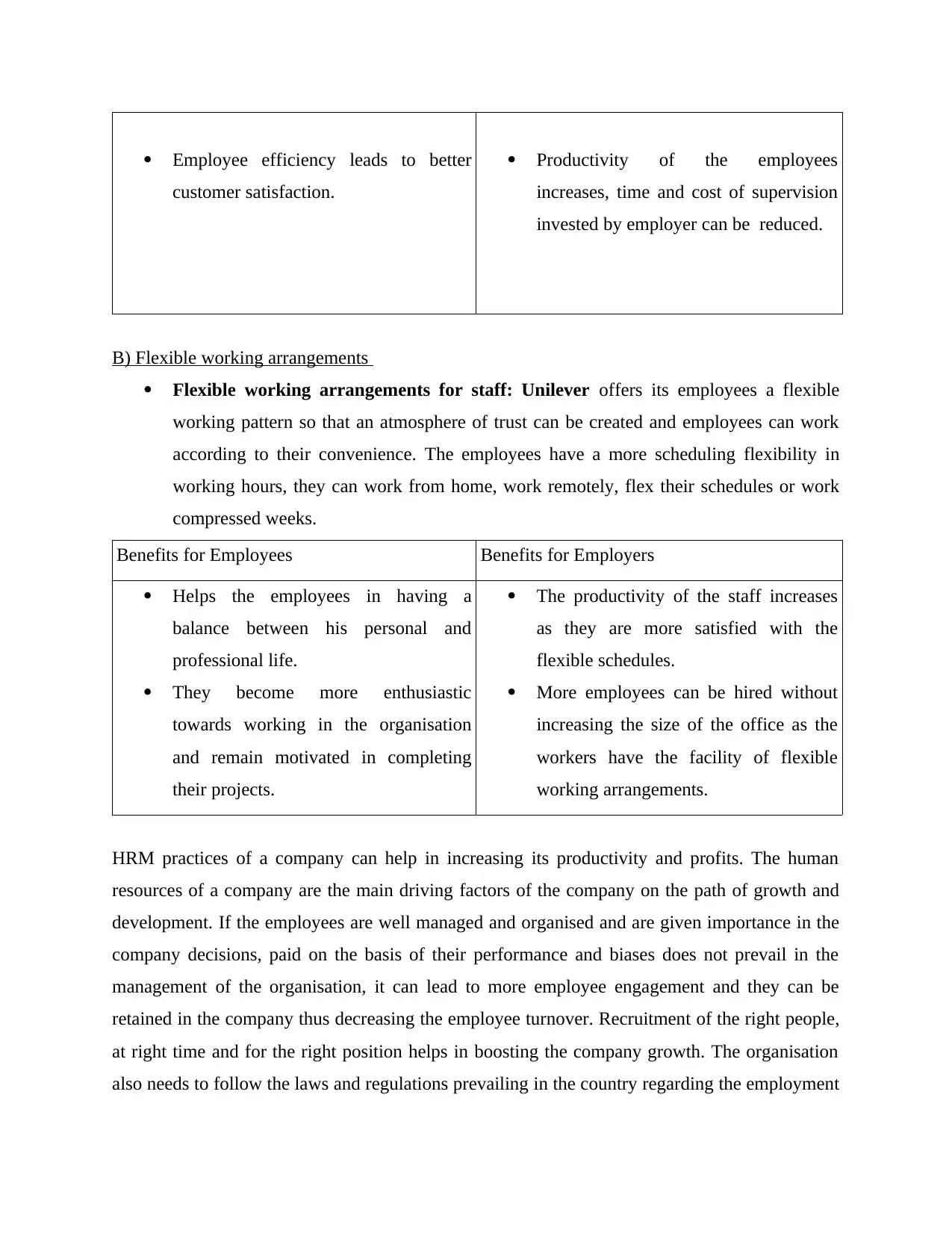
Employee efficiency leads to better
customer satisfaction.
Productivity of the employees
increases, time and cost of supervision
invested by employer can be reduced.
B) Flexible working arrangements
Flexible working arrangements for staff: Unilever offers its employees a flexible
working pattern so that an atmosphere of trust can be created and employees can work
according to their convenience. The employees have a more scheduling flexibility in
working hours, they can work from home, work remotely, flex their schedules or work
compressed weeks.
Benefits for Employees Benefits for Employers
Helps the employees in having a
balance between his personal and
professional life.
They become more enthusiastic
towards working in the organisation
and remain motivated in completing
their projects.
The productivity of the staff increases
as they are more satisfied with the
flexible schedules.
More employees can be hired without
increasing the size of the office as the
workers have the facility of flexible
working arrangements.
HRM practices of a company can help in increasing its productivity and profits. The human
resources of a company are the main driving factors of the company on the path of growth and
development. If the employees are well managed and organised and are given importance in the
company decisions, paid on the basis of their performance and biases does not prevail in the
management of the organisation, it can lead to more employee engagement and they can be
retained in the company thus decreasing the employee turnover. Recruitment of the right people,
at right time and for the right position helps in boosting the company growth. The organisation
also needs to follow the laws and regulations prevailing in the country regarding the employment
customer satisfaction.
Productivity of the employees
increases, time and cost of supervision
invested by employer can be reduced.
B) Flexible working arrangements
Flexible working arrangements for staff: Unilever offers its employees a flexible
working pattern so that an atmosphere of trust can be created and employees can work
according to their convenience. The employees have a more scheduling flexibility in
working hours, they can work from home, work remotely, flex their schedules or work
compressed weeks.
Benefits for Employees Benefits for Employers
Helps the employees in having a
balance between his personal and
professional life.
They become more enthusiastic
towards working in the organisation
and remain motivated in completing
their projects.
The productivity of the staff increases
as they are more satisfied with the
flexible schedules.
More employees can be hired without
increasing the size of the office as the
workers have the facility of flexible
working arrangements.
HRM practices of a company can help in increasing its productivity and profits. The human
resources of a company are the main driving factors of the company on the path of growth and
development. If the employees are well managed and organised and are given importance in the
company decisions, paid on the basis of their performance and biases does not prevail in the
management of the organisation, it can lead to more employee engagement and they can be
retained in the company thus decreasing the employee turnover. Recruitment of the right people,
at right time and for the right position helps in boosting the company growth. The organisation
also needs to follow the laws and regulations prevailing in the country regarding the employment
Paraphrase This Document
Need a fresh take? Get an instant paraphrase of this document with our AI Paraphraser
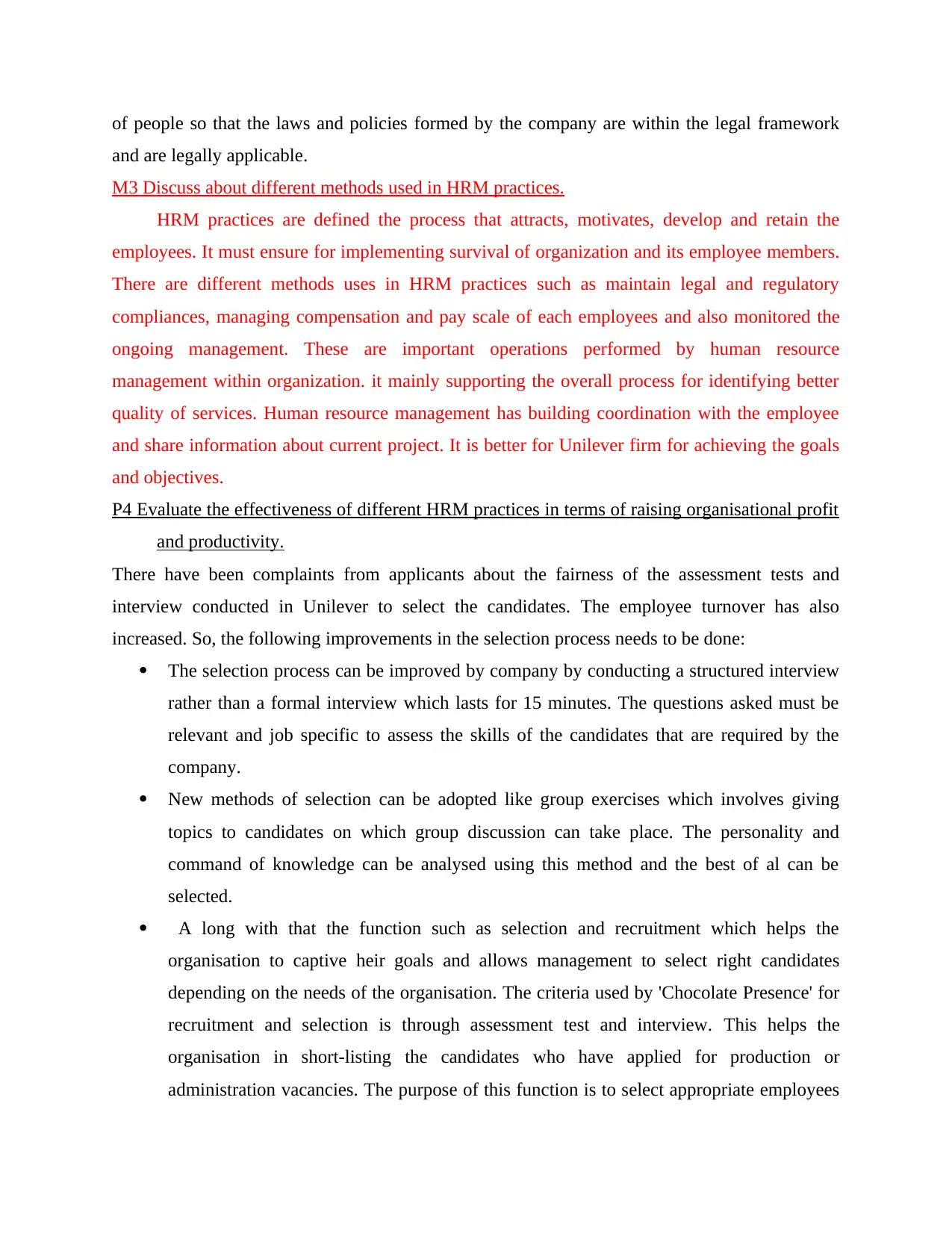
of people so that the laws and policies formed by the company are within the legal framework
and are legally applicable.
M3 Discuss about different methods used in HRM practices.
HRM practices are defined the process that attracts, motivates, develop and retain the
employees. It must ensure for implementing survival of organization and its employee members.
There are different methods uses in HRM practices such as maintain legal and regulatory
compliances, managing compensation and pay scale of each employees and also monitored the
ongoing management. These are important operations performed by human resource
management within organization. it mainly supporting the overall process for identifying better
quality of services. Human resource management has building coordination with the employee
and share information about current project. It is better for Unilever firm for achieving the goals
and objectives.
P4 Evaluate the effectiveness of different HRM practices in terms of raising organisational profit
and productivity.
There have been complaints from applicants about the fairness of the assessment tests and
interview conducted in Unilever to select the candidates. The employee turnover has also
increased. So, the following improvements in the selection process needs to be done:
The selection process can be improved by company by conducting a structured interview
rather than a formal interview which lasts for 15 minutes. The questions asked must be
relevant and job specific to assess the skills of the candidates that are required by the
company.
New methods of selection can be adopted like group exercises which involves giving
topics to candidates on which group discussion can take place. The personality and
command of knowledge can be analysed using this method and the best of al can be
selected.
A long with that the function such as selection and recruitment which helps the
organisation to captive heir goals and allows management to select right candidates
depending on the needs of the organisation. The criteria used by 'Chocolate Presence' for
recruitment and selection is through assessment test and interview. This helps the
organisation in short-listing the candidates who have applied for production or
administration vacancies. The purpose of this function is to select appropriate employees
and are legally applicable.
M3 Discuss about different methods used in HRM practices.
HRM practices are defined the process that attracts, motivates, develop and retain the
employees. It must ensure for implementing survival of organization and its employee members.
There are different methods uses in HRM practices such as maintain legal and regulatory
compliances, managing compensation and pay scale of each employees and also monitored the
ongoing management. These are important operations performed by human resource
management within organization. it mainly supporting the overall process for identifying better
quality of services. Human resource management has building coordination with the employee
and share information about current project. It is better for Unilever firm for achieving the goals
and objectives.
P4 Evaluate the effectiveness of different HRM practices in terms of raising organisational profit
and productivity.
There have been complaints from applicants about the fairness of the assessment tests and
interview conducted in Unilever to select the candidates. The employee turnover has also
increased. So, the following improvements in the selection process needs to be done:
The selection process can be improved by company by conducting a structured interview
rather than a formal interview which lasts for 15 minutes. The questions asked must be
relevant and job specific to assess the skills of the candidates that are required by the
company.
New methods of selection can be adopted like group exercises which involves giving
topics to candidates on which group discussion can take place. The personality and
command of knowledge can be analysed using this method and the best of al can be
selected.
A long with that the function such as selection and recruitment which helps the
organisation to captive heir goals and allows management to select right candidates
depending on the needs of the organisation. The criteria used by 'Chocolate Presence' for
recruitment and selection is through assessment test and interview. This helps the
organisation in short-listing the candidates who have applied for production or
administration vacancies. The purpose of this function is to select appropriate employees
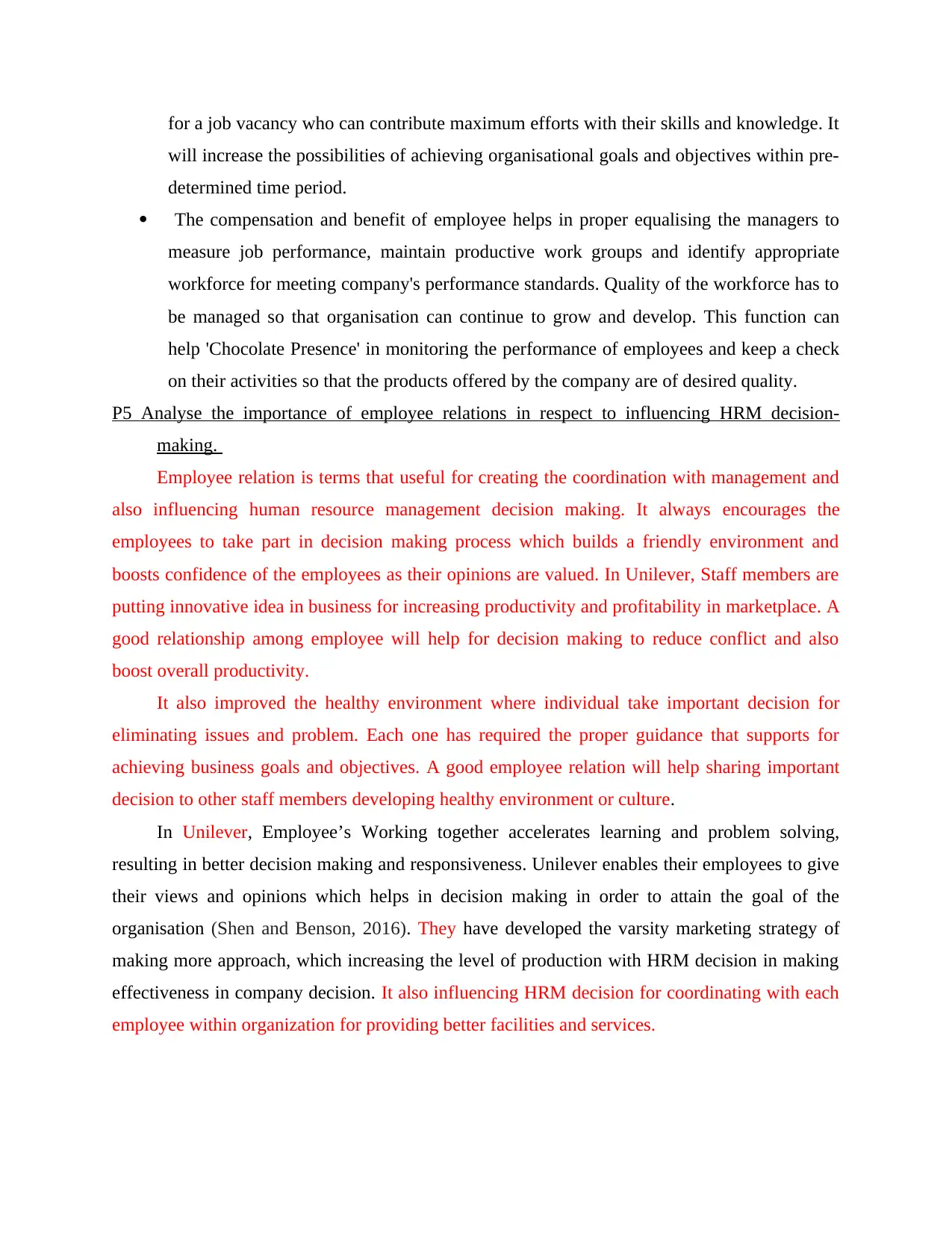
for a job vacancy who can contribute maximum efforts with their skills and knowledge. It
will increase the possibilities of achieving organisational goals and objectives within pre-
determined time period.
The compensation and benefit of employee helps in proper equalising the managers to
measure job performance, maintain productive work groups and identify appropriate
workforce for meeting company's performance standards. Quality of the workforce has to
be managed so that organisation can continue to grow and develop. This function can
help 'Chocolate Presence' in monitoring the performance of employees and keep a check
on their activities so that the products offered by the company are of desired quality.
P5 Analyse the importance of employee relations in respect to influencing HRM decision-
making.
Employee relation is terms that useful for creating the coordination with management and
also influencing human resource management decision making. It always encourages the
employees to take part in decision making process which builds a friendly environment and
boosts confidence of the employees as their opinions are valued. In Unilever, Staff members are
putting innovative idea in business for increasing productivity and profitability in marketplace. A
good relationship among employee will help for decision making to reduce conflict and also
boost overall productivity.
It also improved the healthy environment where individual take important decision for
eliminating issues and problem. Each one has required the proper guidance that supports for
achieving business goals and objectives. A good employee relation will help sharing important
decision to other staff members developing healthy environment or culture.
In Unilever, Employee’s Working together accelerates learning and problem solving,
resulting in better decision making and responsiveness. Unilever enables their employees to give
their views and opinions which helps in decision making in order to attain the goal of the
organisation (Shen and Benson, 2016). They have developed the varsity marketing strategy of
making more approach, which increasing the level of production with HRM decision in making
effectiveness in company decision. It also influencing HRM decision for coordinating with each
employee within organization for providing better facilities and services.
will increase the possibilities of achieving organisational goals and objectives within pre-
determined time period.
The compensation and benefit of employee helps in proper equalising the managers to
measure job performance, maintain productive work groups and identify appropriate
workforce for meeting company's performance standards. Quality of the workforce has to
be managed so that organisation can continue to grow and develop. This function can
help 'Chocolate Presence' in monitoring the performance of employees and keep a check
on their activities so that the products offered by the company are of desired quality.
P5 Analyse the importance of employee relations in respect to influencing HRM decision-
making.
Employee relation is terms that useful for creating the coordination with management and
also influencing human resource management decision making. It always encourages the
employees to take part in decision making process which builds a friendly environment and
boosts confidence of the employees as their opinions are valued. In Unilever, Staff members are
putting innovative idea in business for increasing productivity and profitability in marketplace. A
good relationship among employee will help for decision making to reduce conflict and also
boost overall productivity.
It also improved the healthy environment where individual take important decision for
eliminating issues and problem. Each one has required the proper guidance that supports for
achieving business goals and objectives. A good employee relation will help sharing important
decision to other staff members developing healthy environment or culture.
In Unilever, Employee’s Working together accelerates learning and problem solving,
resulting in better decision making and responsiveness. Unilever enables their employees to give
their views and opinions which helps in decision making in order to attain the goal of the
organisation (Shen and Benson, 2016). They have developed the varsity marketing strategy of
making more approach, which increasing the level of production with HRM decision in making
effectiveness in company decision. It also influencing HRM decision for coordinating with each
employee within organization for providing better facilities and services.
⊘ This is a preview!⊘
Do you want full access?
Subscribe today to unlock all pages.

Trusted by 1+ million students worldwide
1 out of 21
Related Documents
Your All-in-One AI-Powered Toolkit for Academic Success.
+13062052269
info@desklib.com
Available 24*7 on WhatsApp / Email
![[object Object]](/_next/static/media/star-bottom.7253800d.svg)
Unlock your academic potential
Copyright © 2020–2025 A2Z Services. All Rights Reserved. Developed and managed by ZUCOL.





